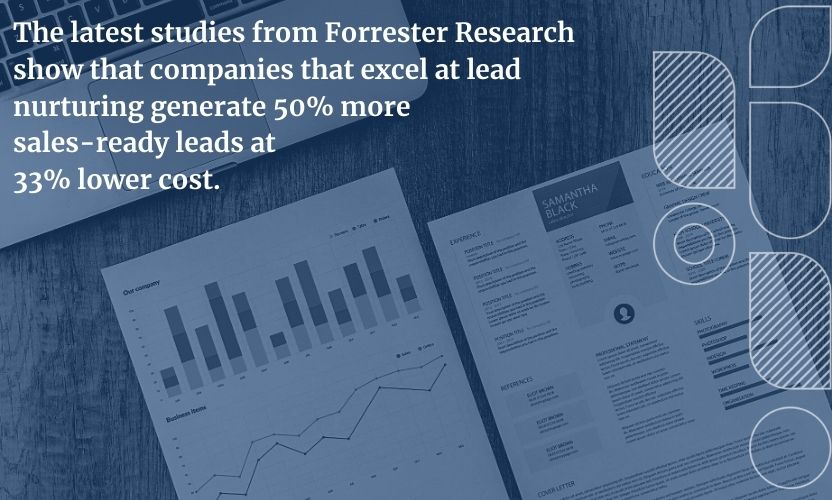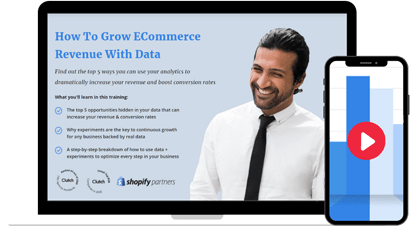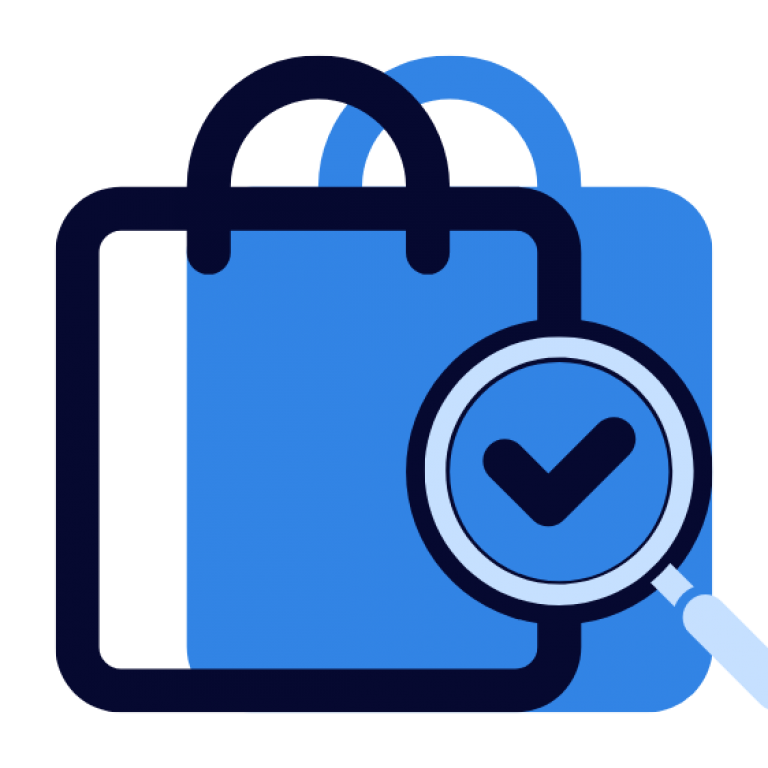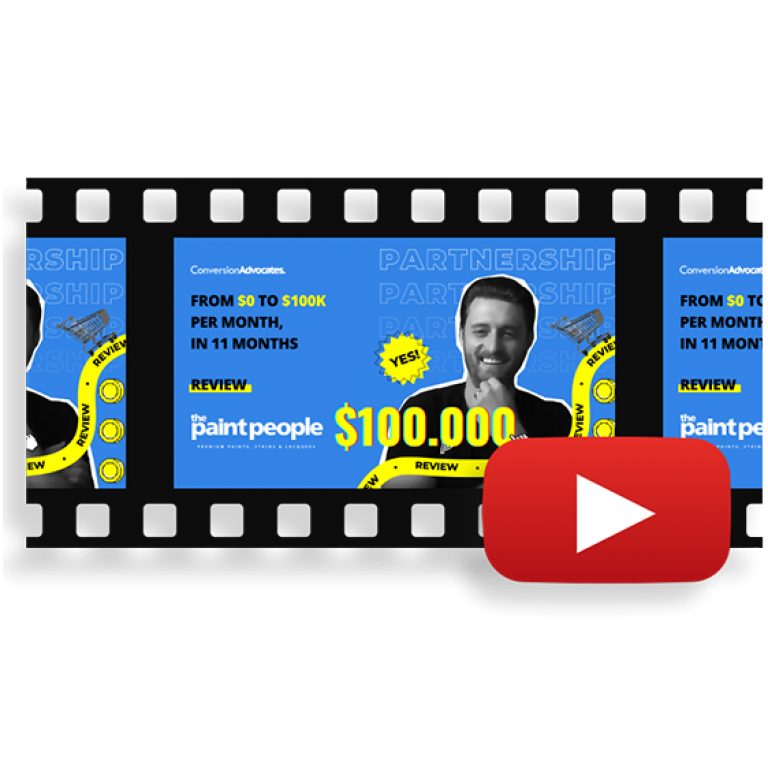a 12-minute read | Editor’s Note: This post was originally published in January 2019 and has been updated in August 2020 for accuracy and comprehensiveness.
You have an amazing business and a product that should practically sell itself. You’ve invested money to drive traffic to your website. And look at that: it’s paying off! People are contacting you, you’re generating leads, and life is good. The problem is that your leads are not converting into paying customers like you feel they should. Half of them are just looking for information, and the other half say that they will consider their options and get back to you. So what’s the problem with your lead conversion? What’s stopping them from reaching the last stop of your sales funnel?

The problem probably lies in how your company engages leads throughout their buying journey. This journey is vital. Get it right, and the leads who intend to buy will quickly convert to actual paying (and even referring) customers. Get it wrong, and you’ll lose them quickly, even those who might have genuinely been interested in making a purchase.
These are some of the key benefits of doing the work to understand your customer’s buying journey:
- Improve customer satisfaction
- Increase lead conversion
- Boost referrals and customer retention
- Turn leads into profit
- Increase conversion rates
Now that we’ve established the importance of it, let’s get started. There are six main stages of customers journey:

Stage One : Interest
How do you know when people are interested in your business? They tell you. Depending on your business, this could happen in a range of ways. They might enter their information on your website, they might comment on your social media, or maybe they’ll be referred by another client.
The common thread here is that someone has shown interest in your company and your services – welcome to Stage One of your customer’s journey. Many of these people may never buy from you, but that’s nothing to lose sleep over for now. The goal here isn’t to get all of them to buy from you. The goal is to figure out who’s genuinely interested and able to pay because this is the group of leads you should be targeting and eventually convince to buy.
Follow these three simple steps to increase lead conversions at Stage One of your sales funnel:
1. Connect with your audience’s needs.
Your customers aren’t all the same. They each have different buying requirements. The better you can tailor your marketing message to what they’re looking for, the higher your conversions will be.
2. “Don’t spill your beans in the lobby”
Wise words from David H. Sandler. What you want to be doing at this early stage is pique your visitor’s interest to the point where they want to learn more. Avoid bombarding them with so much information that they have no reason to contact you.
3. Play it cool.
As soon as people feel like you’re trying too hard to sell them, it’s all over. The important thing is to be clear, concise, and make sure you present everything thoughtfully and show the value you are offering to your customer clearly.
Stage Two: Evaluation
Now your leads are looking for a reason to buy. They want to feel like they’re making the best decision and getting the best deal possible. It’s your chance to lay out the reasons for them to buy from you, rather than anyone else. That’s why Stage Two of your customer’s journey is for them to acquire more information about your offer and how it benefits them.
To move your leads to the next stage of the journey, you need to show them the value you provide and explain why they should choose you instead of a competitor. Always think about how you stack up against all alternatives. That doesn’t just include direct competitors, but also any other possibilities your customers could choose.
Let’s look at an example. If you run a cleaning business, an alternative to hiring your company would be for the person to do the cleaning by him/herself. To grab the lead’s attention, you’ll need to frame your offer in a way that communicates why he/she should get cleaning done with you instead of just doing it personally. Stage Two — the Evaluation Stage — is your time to connect your offer to the prospective buyer’s needs. The better the connection, the more likely they are to buy.
Three steps for increasing lead conversions at Stage Two of your sales funnel:
1. Find out why your leads aren’t buying.
Sometimes we think we know why, but the real reasons are completely different. The simplest way to find out is just to ask your potential customers directly. Send them an email or give them a call, and ask for some honest feedback. You’ll be surprised by the number of responses. You could also run short surveys using Qeryz or Quaraloo, and ask people what you can be doing better. One way or another, do your best to gain insight on how you can improve from the people who matter most – your prospective customers.
2. Don’t waste good resources on unqualified leads.
It’s an easy trap to fall into, but chasing after potential customers that you know aren’t right for your business will distract you from finding those others who are more likely to make a purchase. Just as your potential customers are evaluating whether or not you’re a good fit for them, you need to evaluate if they’re a good fit for your business. If they’re not a good fit, know when it’s time to call it a day.
3. Segment your leads.
This will help you understand what to do next within your sales funnel. There are a lot of different ways to segment leads but we typically use four different levels to segment leads based on their interest level to decide which stage they might be at:
- Interested: They’re genuinely interested in your company and ready to purchase right away.
- Somewhat Interested: They’re ready to purchase, but they’re shopping around to see what you can offer versus your competitors. They just want a ballpark quote.
- Not Now; in the Future: They’re interested in learning more about your service, but they aren’t ready to buy just yet.
- Completely Unqualified: They’re looking for pool supplies, and you run a hair salon.
Stage Three: Consideration
Fact number one: You spent a lot of time and money acquiring your leads.
Fact number two: They contacted you because they’re genuinely interested in your service.
There’s no reason to say goodbye to these leads because they aren’t ready to convert today. If prospective customers need your services, but for some reason, can’t make the jump right now, maintain contact with them, and nurture them until they’re ready. When you nurture your leads, you establish a relationship, build trust, and demonstrate your value. The length of time a lead stays in the consideration stage (and the length of time you will need to nurture them) depends on your product and on how big of an impact it will have on your customer’s life.
For example, imagine a software company that targets large businesses with a product that requires major onboarding from all levels. This company’s potential customers will stay in the consideration stage much longer than they would for an internet provider that offers its customers a 30-day, money-back guarantee, for instance. The quicker the onboarding, the shorter the customer’s patience.

Three simple ways to increase lead conversions at Stage Three of your sales funnel:
1. Focus on creating value.
It doesn’t matter how targeted, personalized, or sales-ready your content is. If it doesn’t create value for your customers, it’s meaningless. Think critically about not only the topic but also how you present your content so that your audience finds it useful and engaging.
2. Create an email nurturing campaign.
Email is not only one of the best ways to connect with your customers, but with an average 3,800% ROI in 2020 it’s one of the most effective available options out there. In 2014, eMarketer cited email marketing as the most effective digital marketing channel for customer retention in the United States. Establish a sequence of emails that will communicate your company’s message, build trust, and, most of all, provide value to your customers. Feel free to check out 50+ free email templates that Sapph Li from the Art of Emails created. They could help you get started.
3. Create a remarketing ad campaign.
Have you ever visited a company’s website and felt like their ads were following you on every other online channel you visited afterward? That’s remarketing. It’s a paid advertising tactic that goes sorely underused by small businesses, mainly because most of them don’t understand how to use it properly.
Stage Four: Commitment
Your lead finally converted into a prospect – sometimes after months of nurturing – who’s ready to commit to a purchase. It’s sold on your product and keen to move forward. Now it’s time to negotiate terms and manage expectations. This is a vital step along the way because it will play a big role in how your customer feels about the sales process and the end product they receive.
We all want to leave our customers happy with our service. Not only does it make us feel warm and fuzzy on the inside, but happy customers will also refer more customers to you. Managing expectations and delivering on them is a simple way to make your customers happy. Be very clear about:
- What you’re delivering
- When you’re expecting to deliver it by
- For how much will you deliver it
Clearly outlining these key deliverables will have an enormous impact on your customer’s happiness at the end of a transaction.
You may have heard the business maxim of under-promising and over-delivering. However, it’s better to be consistent and clearly outline deliverables than to try to surprise your customers with something they didn’t ask for or expect you to do. Don’t make life harder for yourself than it needs to be. Think of the Commitment Stage as if you’re laying up for a slam-dunk. You haven’t scored the point yet, and you still need to make your way to the net without getting blocked. Don’t let overconfidence or haste trip you up now.
Our top three tips for increasing lead conversions at Stage Four:
1. Be transparent.
It may seem scary to mention anything that could potentially cause you to lose a customer, but it’s important to be honest about your product. Omitting downsides can surprise your customer and leave them feeling dissatisfied. You’re better off mentioning potential problems, challenges, or defects upfront, and proposing a solution to address the situation if it arises. This way, you demonstrate that you’re in control and build trust with your client.
2. Clearly outline deliverables.
Create any uncertainty about your offer, and you’ll start to see delays about finalizing the purchase — or worse, cause your potential customer to back out at the last minute. For example, if a prospect is about to purchase a service for house cleaning online, it will want to know these things:
- When are they coming to clean?
- How they plan on getting in?
- How long they’re going to stay?
- What number of rooms they’re going to clean?
- What items are not included in the service?
- Whether a client needs to provide cleaning supplies?
- How much it will all cost?
If any of these items are missing, there’s a good chance a prospect is going to delay the purchase or find a cleaning company that answers its questions upfront. According to the latest research by Forrester, 45% of US consumers will abandon an online transaction if their questions or concerns are not addressed quickly.
3. Create a sense of urgency.
When given the chance, people tend to procrastinate on making a decision. That’s why it’s important to give people a logical reason to buy sooner rather than later. The goal isn’t to force them to buy, but instead to stop them from procrastinating. Marcus Taylor from ConvesrionXL explained thoroughly five different ways to create direct or implied urgency that could come in handy.
Stage Five: Conversion
Congratulations! You’ve made it through the trenches. You’ve received payment and you’re ready to deliver your product. This is when most businesses think their customers reached the bottom of the sales funnel. For many, it may be true. But for others, like you, it could be just the beginning. If your sales funnel ends here, you leave a potential treasure trove of opportunity behind. Now is the time to think about the next stage of your customer’s journey: satisfaction.
Your objective at the Conversion Stage is to create positive and memorable experiences for your customer. Your customers aren’t just buying the product or service you offer. They’re also buying the experience and customer service you provide.
Here’s an example of a happy customer – our CEO, Sina Fak:
“One of my favorite Toronto-based companies is Freshbooks. They provide cloud-based accounting software that’s not only functional but also terrific in the user-interface department. That being said, Freshbooks has a number of competitors that provide equally functional accounting software with good UI. What separates Freshbooks from the rest is their customer support and their users’ experience with their product. I don’t think I’ve ever waited more than two minutes to talk to support at Freshbooks and I’ve always had my questions answered in under five minutes. My glowing recommendation of Freshbooks just shows how the experience you give your customer after they purchase is every bit as important as the product or service you’re selling.”
Five easy ways to increase conversions at Stage Five:
1. Pay attention to detail.
It’s the little things people remember and talk about. You don’t need to make any dramatic gestures; just think about how you would like to be treated if you were in your customer’s shoes. Let’s continue with our cleaning company example: a small gesture could be as simple as writing a short thank you note, or leaving some complimentary incense in the bathroom. The point is to engage your customer in a way that will stand out in their minds.
2. Always listen.
Take a genuine interest in what your customer has to say and be respectful of their mood when resolving any issues with your company. According to McKinsey, 70% of buying experiences are based on how the customer feels they’re being treated.
3. Assume responsibility.
Your customer is always right – even when they’re wrong. The best businesses in the world are founded on this principle. Do whatever it takes to make your customer happy. One bad review or unfavorable word-of-mouth could cost you a lot more than the cost of servicing one unhappy customer. At the same time, this principle only works if you choose your customers carefully. Know whom you’re doing business with, and focus on finding customers who make you want to go the extra mile. Parature explains that it takes 12 positive customer experiences to make up for one negative experience.
Stage Six: Satisfaction
Throughout your customer’s journey, you did everything in your power to ensure customer’s complete satisfaction. Now that the work is done – it’s time to follow up. Fresh from their great experience with you, this is the best time to ask for a referral or a review or to pitch any upsells your company offers.
Referrals are the backbone of any good business, and reviews build confidence and the trust of other buyers. You need them, but the sad truth is that most satisfied customers won’t give referrals or provide reviews unless they’re reminded or given an incentive to do so. Even if you’re getting reviews and referrals naturally without lifting a finger, just imagine how many more you could be getting if you simplified and incentivized the process. Put simply – you provide an excellent service that is satisfying your customer. You should get rewarded for your good work, and the good word should be shouted from the rooftops.
Three simple tips for increasing conversions at the final Stage Six:
1. Keep it simple.
Many clients would happily write a review, but don’t know how to go about it. Make it as easy for them as possible. Here are some suggestions:
- Send your clients a friendly email with direct links to places where they can write a review (Google+, Facebook, LinkedIn, HomeStars, etc).
- Offer a short guide to help your customers write their testimonial.
- Ask if they’d like you to draft a review or referral for their approval. In most cases, they’ll say yes, and thank you for making their life easier.
2. Create case studies.
When you have a great customer success story that you want to capture, create a case study. This way, you can highlight all the important details of your work, and thoroughly explain what happened. Remember, your goal is to educate potential readers about your process and capabilities, not to show off your case study. The case study needs to create value for your readers. Most customers will also let you quote a testimonial to include in the case study. A verbal testimonial is much easier to get than a written one.
3. Give something away.
Money isn’t your only compensation. Target big clients in your industry and offer your services for free in exchange for a testimonial. After you’re done, you can leverage their story to get higher-paying clients in the future.
Some final thoughts
- You work hard in your business to provide exceptional service with outstanding quality.
- You deserve referrals – but you need to give your customer the tools and a reason to refer their friends to you.
- Understanding the journey your customer takes at every stage of the sales funnel means you can improve their experience with your company, not just your final product.
- If you’re only focusing on the final product and not your customer experience, then you’re just a commodity. Your success depends on the experience you give your customers, before, during, and after the purchase.



